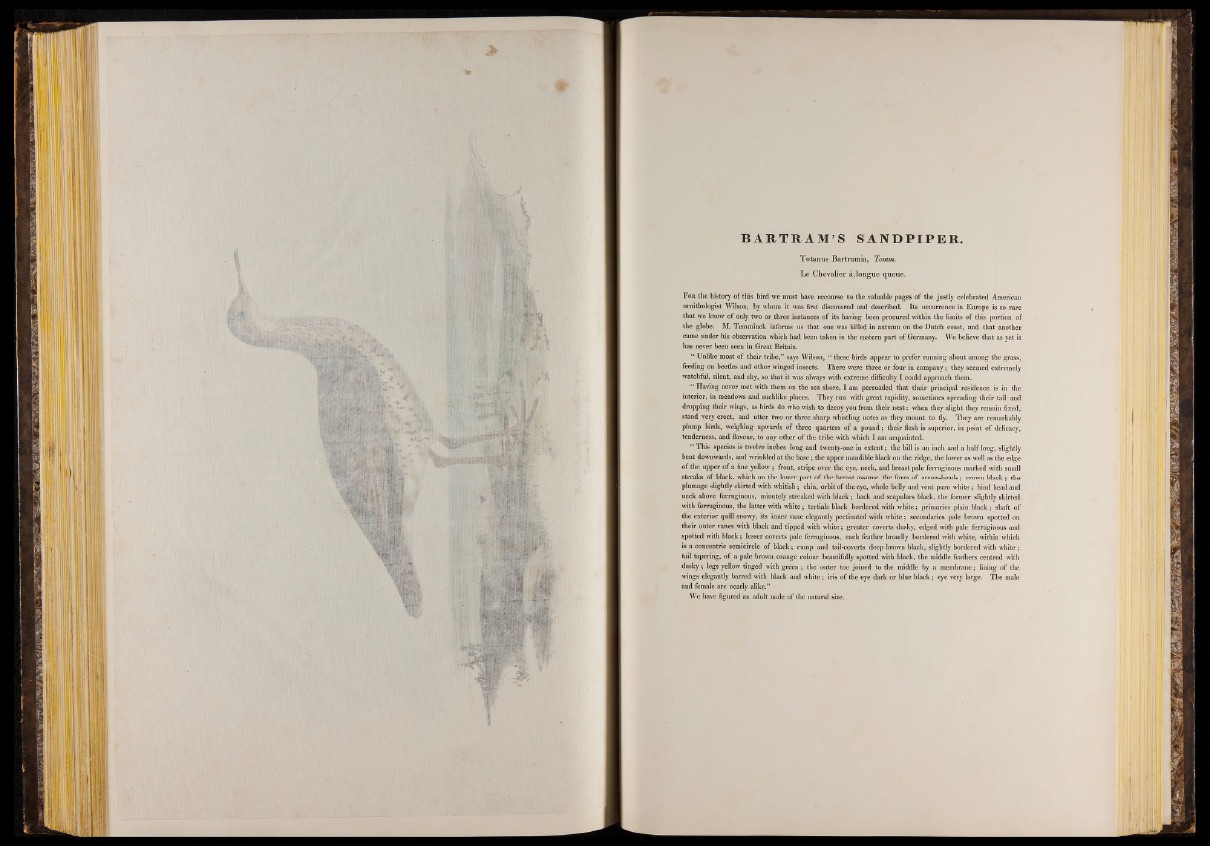
B A R T R AM ’ S SANDPI PE R .
Totanus Bartramia, Temm.
Le Chevalier ¿.¡longue queue.
For the history o f this bird we must have recourse to the valuable pages o f the justly celebrated American
ornithologist Wilson, by whom it was first discovered and described. Its occurrence in Europe is so rare
that we know of only two or three instances o f its having been procured within the limits o f this portion of
the globe. M. Temminck informs us that one was killed in autumn on the Dutch coast, and that another
came under his observation which had been taken in the eastern part o f Germany. We believe that as yet it
has never been seen in Great Britain.
“ Unlike most o f their tribe,” says Wilson, “ these birds appear to prefer running about among the grass,
feeding on beetles and other winged insects. There were three or four in company; they seemed extremely
watchful, silent, and shy, so that it was always with extreme difficulty I could approach them.
“ Having never met with them on the sea shore, I am persuaded that their principal residence is in the
interior, in meadows and suchlike places. They run with great rapidity, sometimes spreading their tail and
dropping their wings, as birds do who wish to decoy you from their nest: when they alight they remain fixed,
stand very erect, and utter two or three sharp whistling notes as they mount to fly. They are remarkably
plump birds, weighing upwards o f three quarters o f a pound; their flesh is superior, in point o f delicacy,
tenderness, and flavour, to any other o f the tribe with which I am acquainted.
“ This species is twelve inches long and twenty-one in extent; the bill is an inch and a half long, slightly
bent downwards, and wrinkled at the base; the upper mandible black on the ridge, the lower as well as the edge
o f the upper o f a fine yellow ; front, stripe over the eye, neck, and breast pale ferruginous marked with small
streaks o f black, which on the lower part o f the breast assume the form o f arrow-heads; crown black; the
plumage slightly skirted with whitish; chin, orbit o f the eye, whole belly and vent pure white; hind head and
neck above ferruginous, minutely streaked with black; back and scapulars black, the former slightly skirted
with ferruginous, the latter with white; tertials black bordered with white; primaries plain black ; shaft of
the exterior quill snowy, its inner vane elegantly pectinated with white; secondaries pale brown spotted on
their outer vanes with black and tipped with white; greater coverts dusky, edged with pale ferruginous and
spotted with black; lesser coverts pale ferruginous, each feather broadly bordered with white, within which
is a concentric semicircle o f black; rump and tail-coverts deep brown black, slightly bordered with white;
tail tapering, of a pale brown orange colour beautifully spotted with black, the middle feathers centred with
dusky; legs yellow tinged with green ; the outer toe joined to the middle by a membrane; lining o f the
wings elegantly barred with black and white; iris o f the eye dark or blue black; eye very large. The male
and female are nearly alike.”
We have figured an adult male o f the natural size.